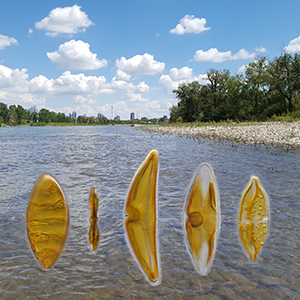Exploring diatom diversity through cultures - a case study from the Bow River, Canada

Accepted: 18 November 2022
HTML: 11
All claims expressed in this article are solely those of the authors and do not necessarily represent those of their affiliated organizations, or those of the publisher, the editors and the reviewers. Any product that may be evaluated in this article or claim that may be made by its manufacturer is not guaranteed or endorsed by the publisher.
Authors
Diatom cultures can help answer taxonomic, biogeographic and ecological questions on a local and global scale. Unialgal cultures are derived from a single cell and provide abundant material for morphological and molecular analyses. The link between the historic morphological species concept and the molecular data is becoming increasingly important with the use of eDNA metabarcoding. Additionally, cultures provide insights into the life cycle of diatoms and thereby complement taxonomy and species ecology. In this study, we present an approach to extract benthic diatoms from an environmental sample to generate unialgal cultures. We explored diatom diversity in preserved assemblages and by culturing as many different taxa as possible from benthic freshwater samples taken on the same day from the Bow River in Calgary, Canada. With both methods we found a total of 221 different benthic diatom taxa, of which 182 were identified in the preserved diatom assemblages. Interestingly, an additional 39 taxa only appeared in the cultures. In total 129 strains were cultivated representing 71 different taxa. This study includes pictures of living cells demonstrating the additional merits of unialgal cultures, as they provide information on plastid details, auxospores and endosymbionts. Both, the identification of the diatom assemblages and the generation and identification of strains provide the foundation for additional water quality assessment tools, taxonomic insights and molecular references libraries.
Edited by
Francesca Bona, Department of Life Sciences and Systems Biology, University of Turin, ItalySupporting Agencies
Verein der Freunde des Botanischen Gartens und Botanischen Museums Berlin Dahlem e.V. , Federal Ministry of Education and Research (German Barcode of Life 2 Diatoms, GBOL2)How to Cite

This work is licensed under a Creative Commons Attribution-NonCommercial 4.0 International License.
Similar Articles
- Margarita Caballero, Alejandro Rodriguez, Gloria Vilaclara, Beatriz Ortega, Priyadarsi Roy, Socorro Lozano-García, Hydrochemistry, ostracods and diatoms in a deep, tropical, crater lake in Western Mexico , Journal of Limnology: Vol. 72 No. 3 (2013)
- Elisabetta Franchi, Antonella Carosi, Lucia Ghetti, Daniela Giannetto, Giovanni Pedicillo, Laura Pompei, Massimo Lorenzoni, Changes in the fish community of the upper Tiber River after construction of a hydro-dam , Journal of Limnology: Vol. 73 No. 2 (2014)
- Rocco Tiberti, Stefano Brighenti, Claudia Canedoli, Rocco Iacobuzio, Matteo Rolla, The diet of introduced brook trout (Salvelinus fontinalis; Mitchill, 1814) in an alpine area and a literature review on its feeding ecology , Journal of Limnology: Vol. 75 No. 3 (2016)
- Baoli Wang, Cong-Qiang Liu, Fushun Wang, Benjamin Chetelat, Stephen C. Maberly, Diatoms modify the relationship between dissolved silicon and bicarbonate in the impounded rivers , Journal of Limnology: Vol. 72 No. 3 (2013)
- Ning Chen, Ling Liu, Yanfeng Li, Danying Qiao, Yuanpo Li, Ying Zhang, Yiyan Lv, Morphology-based classification of functional groups for potamoplankton , Journal of Limnology: Vol. 74 No. 3 (2015)
- Walter Finsinger, Thierry Fonville, Emiliya Kirilova, Andrea Lami, Piero Guilizzoni, André F. Lotter, A long-term multi-proxy record of varved sediments highlights climate-induced mixing-regime shift in a large hard-water lake ~5000 years ago , Journal of Limnology: Vol. 73 No. 2 (2014)
- Francesca Bona, Valentina La Morgia, Stefano Fenoglio, Luana Morandi, Elisa Falasco, Diatom communities and ecological status classification in the upper Po River basin , Journal of Limnology: Vol. 80 No. 3 (2021): Celebratory Issue - 80th Anniversary of the Journal of Limnology
- Arpana Yadav, Lalit Kumar Pandey, In situ effects of arsenic, aluminium and chromium stresses on algal periphyton of the river Ganga at Varanasi, India , Journal of Limnology: Vol. 82 (2023)
- Wenzhi Wei, Riming Chen, Liufu Wang, Lixia Fu, Spatial distribution of crustacean zooplankton in a large river-connected lake related to trophic status and fish , Journal of Limnology: Vol. 76 No. 3 (2017)
- Amanda Valois, Keith Somers, Chantal Sarrazin-Delay, Wendel (Bill) Keller, Are bioassessments based on the reference condition approach affected by rapid approaches to sample collection and processing? , Journal of Limnology: Vol. 75 No. 2 (2016)
<< < 1 2 3 4 5 6 7 8 9 10 > >>
You may also start an advanced similarity search for this article.
-
Katherina Schimani, Nélida Abarca, Oliver Skibbe, Heba Mohamad, Regine Jahn, Wolf-Henning Kusber, Gabriela Laura Campana, Jonas ZimmermannMetabarcoding and Metagenomics : 2023

 https://doi.org/10.4081/jlimnol.2022.2095
https://doi.org/10.4081/jlimnol.2022.2095





